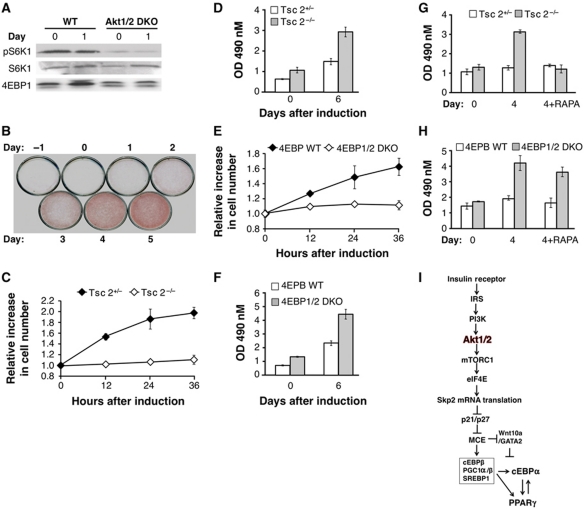Figure 8.
Akt promotes MCE and adipocyte differentiation by activating mTORC1 and eIF4E. (A) mTORC1 activity, as measured by S6K1 phosphorylation and 4E-BP1 mobility shift, is induced upon induction of differentiation in WT but not in Akt1/2 DKO preadipocytes. Protein extracts were isolated from cells at the indicated time points and subjected to immunoblotting using anti-pS6K1, S6K1, and 4E-BP1 antibodies. (B) Rapamycin inhibits adipocyte differentiation only if the cells are exposed to rapamycin within the first 2 days post induction of differentiation. WT preadipocytes were subjected to the adipocyte differentiation protocol and were exposed to rapamycin at the indicated days post induction of differentiation. Differentiation was assessed by Oil-red-O staining. (C) mTORC1 activation is sufficient to promote MCE following induction of differentiation. Tsc2−/−p53−/− and Tsc2+/−p53−/− MEFs were grown to confluency and induced to differentiate. Cell numbers were quantified at the indicated time points post induction of differentiation. Results represent the average ±s.e. of three independent experiments. (D) mTORC1 activation accelerates adipocytes differentiation. Tsc2−/−p53−/− and Tsc2+/−p53−/− were subject to adipocyte differentiation protocol. Differentiation was quantified after Oil-red-O staining and measuring absorbance at 490 nm. Results represent the average ±s.e. of three independent experiments. (E) Activation of eIF4E is sufficient to promote MCE following induction of differentiation. WT (p53−/−) and 4E-BP1/2 (p53−/−) DKO MEFs were grown to confluency and induced to differentiate. Cell numbers were quantified at the indicated time points post induction of differentiation. Results represent the average ±s.e. of three independent experiments. (F) Activation of eIF4E accelerates adipocyte differentiation. Cells were subjected to adipocyte differentiation protocol. Differentiation was quantified after Oil-red-O staining and measuring absorbance at 490 nm. Results represent the average ±s.e. of three independent experiments. (G) Adipocyte differentiation of Tsc2−/− cells is sensitive to rapamycin. Experiments were done as in (D) except that the cells were also treated with rapamycin for the period of differentiation. (H) Adipocyte differentiation of 4E-BP1/2 DKO cells is resistant to rapamycin. Experiments were done as in (F) except that the cells were also treated with rapamycin for the period of differentiation. (I) A schematic illustration showing the mechanism by which Akt regulates adipogenesis. Through the activation of mTORC1 and the phosphorylation of 4E-BP, Akt elevates eIF4E activity, which in turn elevates Skp2 mRNA translation. Elevated Skp2 protein promotes MCE through the degradation of p21 and p27 proteins. MCE enables the initiation of a transcriptional cascade that governs adipocyte differentiation.

